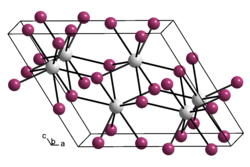 | |
| Identifiers | |
|---|---|
3D model (JSmol) | |
| |
| |
| Properties | |
| As2W | |
| Molar mass | 333.68 g·mol−1 |
| Appearance | black solid [1] |
| Density | 6.9 g·cm−3 [1] |
| practically insoluble [2] | |
Except where otherwise noted, data are given for materials in their standard state (at 25 °C [77 °F], 100 kPa). | |
Tungsten diarsenide is an arsenide of tungsten with the chemical formula WAs2. Other tungsten arsenides include tungsten triarsenide (WAs3) and ditungsten triarsenide (W2As3). [1] [3]